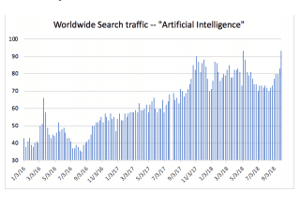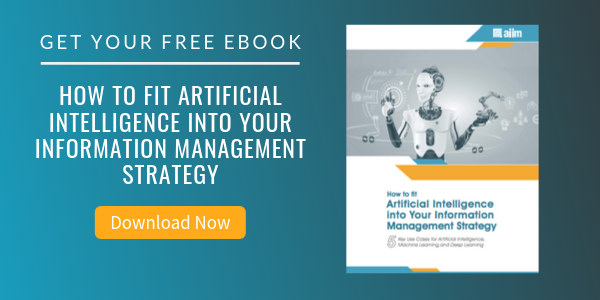
A Brief History of Artificial Intelligence
 Artificial Intelligence (AI) is obviously all the rage. Consider the search traffic on “Artificial Intelligence” since early 2016. As a result, just about every technology product in the world now seems to have the artificial intelligence “label” attached to it.
Artificial Intelligence (AI) is obviously all the rage. Consider the search traffic on “Artificial Intelligence” since early 2016. As a result, just about every technology product in the world now seems to have the artificial intelligence “label” attached to it.
This is ironic because AI has actually been with us for decades, not months. People have been thinking about the relationship between people and machines going all the way back to ancient times, and process automation goes back to the early 20th century. Frank Chen, a partner at Andreessen Horowitz, does a great job discussing the origins of modern AI in AI, Machine Learning, and Deep Learning: A Primer. He notes that in the Summer of 1956, a group of computer scientists came together as the Dartmouth Summer Research Project on Artificial Intelligence to program computers to behave like humans.
“Expert systems” – a form of AI – emerged in the late 70s and really took off in the 80s and allowed a person to create encoded rulesets to automate specific tasks. Airlines are one example of how they used expert systems to help with ticket pricing and trip provisioning.
This core focus of AI – understanding exactly how something is done, turning these steps and actions into rules, and computerizing them – governed the discipline until recently. So what’s so different now about AI, and how does it need to be incorporated into your thinking about process automation?
All along, a different variation of Artificial Intelligence– based on emulating the human brain and how it learns, or machine learning – co-existed with this rule-based school of AI. But optimizing machine learning struggled for many years from a lack of computing power, a lack of data, and a lack of resources. Obviously, all of that has now changed. All around us are examples of the triumph of machine learning and its potential to create exponentially greater possibilities than traditional rules-based approaches.
So as you consider this short history, what kinds of questions should you be asking about AI? In particular, how should you view AI in the context of automating the processing of documents? Learn about 5 questions to determine whether your AI solution for document automation is really intelligent.
About John Mancini
John Mancini is the President of Content Results, LLC and the Past President of AIIM. He is a well-known author, speaker, and advisor on information management, digital transformation and intelligent automation. John is a frequent keynote speaker and author of more than 30 eBooks on a variety of topics. He can be found on Twitter, LinkedIn and Facebook as jmancini77. Recent keynote topics include: The Stairway to Digital Transformation Navigating Disruptive Waters — 4 Things You Need to Know to Build Your Digital Transformation Strategy Getting Ahead of the Digital Transformation Curve Viewing Information Management Through a New Lens Digital Disruption: 6 Strategies to Avoid Being “Blockbustered” Specialties: Keynote speaker and writer on AI, RPA, intelligent Information Management, Intelligent Automation and Digital Transformation. Consensus-building with Boards to create strategic focus, action, and accountability. Extensive public speaking and public relations work Conversant and experienced in major technology issues and trends. Expert on inbound and content marketing, particularly in an association environment and on the Hubspot platform. John is a Phi Beta Kappa graduate of the College of William and Mary, and holds an M.A. in Public Policy from the Woodrow Wilson School at Princeton University.



